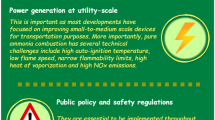Abstract
In quenching tests of downward propagation in stoichiometric methane-air mixtures based on flammability limits and flame speed data, Halon 1301 was about five times more effective, on a volumetric basis, than carbon dioxide as an extinguishant.
Similar content being viewed by others
References
Burgess, D. S. and Kuchta, J. M., “Effectiveness of Halogenated Agents Against Gaseous Explosions and Propelleant Fires,” Symposium on an Appraisal of Halogenated Fire Extinguishing Agents, National Academy of Science, April 11–12, 1972, Washington, DC, pp. 257–277.
Coward, H. F. and Hartwell, F. J., “Studies in the Mechanisms of Flame Movement, I. The Uniform Movement of Flame in Mixtures of Methane and Air in Relation to Tube Diameter,”Journal of the Chemical Society, (1932), pp. 1966–2004.
Coward, H. F. and Jones, G. W., “Limits of Flammability of Gases and Vapors,” Bureau of Mines Bulletin 503, 1952, p. 155.
Creitz, E. C., “Inhibition of Diffusion Flames by Methyl Bromide and Trifluoromethyl Bromide Applied to the Fuel and Oxygen Side of the Reaction Zone.”Journal of Research, National Bureau of Standards, 65A, (1961), pp. 389–395.
Downing, R. C., Eisman, B. J. Jr., and Malcolm, J. E., “Halogenated Extinguishing Agents,” NFPAQuarterly (October 1951), p. 14.
Halpern, C., “Effect of Some Halogenated Hydrocarbons on the Flame Speed of Methane,”Journal of Research, National Bureau of Standards, 70A, (1966), pp. 133–141.
Jost, W.,Diffusion of Solids, Liquids and Gases, (Academic Press, New York, 1952), p. 20.
Jost, W., ibid., p. 408.
Liebman, I., Corry, J. and Perlee, H. E., “Dynamics of Flame Propagation Through Layered Methane-Air Mixtures,”Combustion Sciences and Technology, Vol. 2 (1971), pp. 365–375.
Miller, D. R., Evers, R. L. and Skinner, G. B., “Effects of Various Inhibitors on Hydrogen-Air Flame Speeds,”Combustion and Flame, Vol. 7 (1963), pp. 137–142.
National Fire Protection Association, “Halogenated Extinguishing Agent Systems-Halon 1301,” NFPA No. 12A, Boston, Mass., 1971, p. 70.
Rosser, W. A., Iname, S. H. Jr., and Wise, H., “Effects of Metal Salts on Premixed Hydrocarbon-Air Flames,”Combustion and Flame, Vol. 7 (1963), pp. 107.
Simmons, R. F. and Wolfhard, H. G., “The Influence of Methyl Bromide on Flames. II. Diffusion Flames,” Transactions of the Faraday Society, Vol. 52 (1955), pp. 53–59.
Zabetakis, Michael G., “Flammability Characteristics of Combustible Gases and Vapors,” Bureau of Mines Bulletin 627 (1965).
Author information
Authors and Affiliations
Additional information
Note: All illustrations supplied through the courtesy of the Bureau of Mines, United States Department of the Interior.
Rights and permissions
About this article
Cite this article
Strasser, A., Liebman, I. & Kuchta, J.M. Methane flame extinguishment with layered halon or carbon dioxide. Fire Technol 10, 25–34 (1974). https://doi.org/10.1007/BF02590510
Issue Date:
DOI: https://doi.org/10.1007/BF02590510




